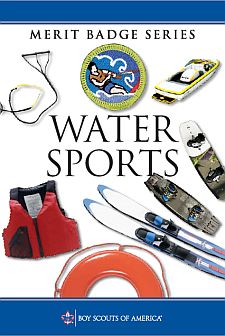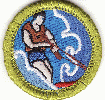These changes were first published in the 2015 edition of the
Water Sports
merit badge pamphlet.
They were also published in the 2016 edition of
Boy Scout Requirements,
but the badge was not identified as having changes.
- Show that you know first aid for injuries or illnesses
that could occur while participating in water sports, including hypothermia,
heat exhaustion, heatstroke, dehydration, sunburn, minor cuts and blisters.
Do the following:- Explain to your counselor the most likely hazards you may encounter while participating in water sports activities and what you should do to anticipate, help prevent, mitigate, and respond to these hazards.
- Review prevention, symptoms, and first-aid treatment for the following injuries or illnesses that could occur while participating in water sports: blisters, cold-water shock and hypothermia, dehydration, heat-related illnesses, sunburn, sprains, strains, minor cuts and bruises, spinal injury, and concussions and head trauma.
- Review the BSA Safety Afloat policy. Tell how it applies to water sports.
- Do the following:
- Identify the conditions that must exist before
performing CPR on a person. Explain how such conditions are recognized.
Discuss with your counselor the characteristics of life jackets most appropriate for water sports, and tell why one must always be worn while waterskiing or wakeboarding. Then demonstrate how to select and fit a life jacket for water sports activities. - Demonstrate proper technique for performing
CPR using a training device approved by your counselor.
Review and discuss the Water Sports Safety Code with your counselor. Promise that you will live up to it and follow it in all water work for this merit badge. Review the safety precautions that must be used by the boat operator in pulling waterskiers and wakeboarders.
- Identify the conditions that must exist before
performing CPR on a person. Explain how such conditions are recognized.
- Before doing the following requirements
4 through 6, successfully complete the BSA
swimmer test.
Jump feetfirst into water over the head in depth. Level off and swim 75 yards in a strong manner using one or more of the following strokes: sidestroke, breaststroke, trudgen, or crawl; then swim 25 yards using an easy, resting backstroke. The 100 yards must be completed in one swim without stops and must include at least one sharp turn. After completing the swim, rest by floating. - Do the following:
- Discuss the BSA Safety Afloat policy. Tell how it applies to Water Sports.
- Name the different types of life jackets, and explain when each type should be used. Show how to choose and properly fit a life jacket.
- Know the Water Sports Safety Code. Promise that you will live up to it and follow it in all water work for this badge. Know the safety precautions that must be used by the boat operator in pulling water-skiers and wakeboarders.
- 6. Showing reasonable control while using
two skis, one ski, or a wakeboard, do EACH of the following:
- Show how to enter the water from a boat and make a deepwater start without help.
- Starting from outside the wakes, show Show you can cross both wakes four times and return to the center of the wake each time without falling.
- Show you can fall properly to avoid an obstacle. Also, show that you can drop handle and coast to a stop without loss of losing your balance.
- 7. While on shore, show that you know how to properly adjust the bindings on of your ski(s) or wakeboard to fit yourself. Then, in deep water, show that you can adjust bindings to fit. Recover and put on your ski(s) or wakeboard that has come off during a fall.
BSA Advancement ID#:
115
Requirements last updated in:
2016
Pamphlet Publication Number:
35963
Pamphlet Stock (SKU) Number:
625494
Pamphlet Revision Date:
2015
|
|||||||
Page updated on: November 18, 2021









